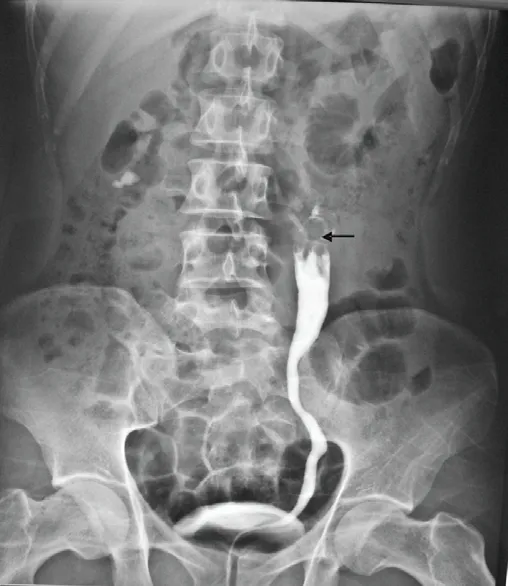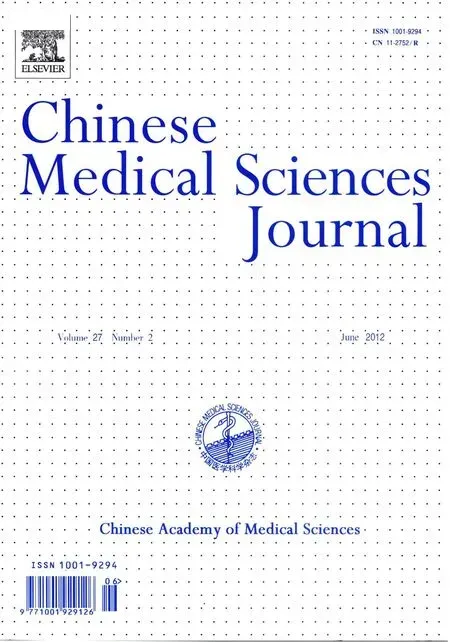Bilateral Ureteral Fibroepithelial Polyps:a Case Report
Ji-rui Niu,Shi Rong,Zhi-gang Ji*,Hua Fan,Jing-min Zhou,and Zhen-yu Zhang
Departments of Urology,Peking Union Medical College Hospital,Chinese Academy of Medical Sciences &Peking Union Medical College,Beijing 100730,China
PRIMARY benign ureteral tumors are rare and they arise from the mesodermal tissue of the ureteral wall.Less than 200 cases have been documented in published reports.1Bilateral ureteral fibroepithelial polyps are extremely rare and commonly occur in the proximal ureter,causing complete ureteral obstruction.Pyeloplasty is an effective treatment for improving renal function.Here we report a case with sequential bilateral ureteral fibroepithelial polyps causing obstructive hydronephrosis.
CASE DESCRIPTION
On August 10th,2011,a 25-year-old man was admitted for recurrent left abdominal and flank pain for 17 years.A diagnosis of hydronephrosis in the right kidney and stone in the left kidney had been made by ultrasound 15 years before in a local hospital.He had received the right dismembered pyeloplasty and pathological result showed ureteral fibroepithelial polyps.After surgery he took oral drug to treat kidney stones.B ultrasound revealed hydronephrosis in the left kidney in our hospital.Both the retrograde pyelography (Fig.1) and computed tomography urography (CTU) showed finger-like polyps obstructing the lumen of the ureter.The99Tcm-mercaptoacetyltriglycine(99Tcm-MAG-3) renal scintigraphy revealed that glomerular filtration rate in the right kidney was 33.47 mL/min,and that in the left kidney was 48.95 mL/min.The finger-like polyp was completely resected and a dismembered pyeloplasty was performed.A double-J catheter stent was left behind.No complications occurred during the postoperative period.Pathologic examination showed benign fibroepithelial polyps.

Figure 1.Retrograde pyelography shows finger-like polyps(arrow).
DISCUSSION
Fibroepithelial polyps of the urinary tract are benign mucosal masses composed of fibrous stroma lined with surface epithelium.2Fibroepithelial polyps are a rare cause of urinary tract obstruction in adults and they are even rarer in children.1The exact etiology of the polyps is uncertain.Various theories have been proposed concerning the cause of ureteral fibroepithelial polyps,including congenital obstruction,trauma,irritation,infection,and specific endogenous and hormonal imbalances.3Most occur on the left side of the proximal ureter and renal pelvis and are usually seen in males.The most common clinical manifestations are hematuria and intermittent flank pain owing to partial ureteral obstruction.4In this case,intermittent flank pain was contributed to complete ureteral obstruction.
B ultrasound is helpful to exclude a calculus which causes ureteral obstruction and visualize a soft tissue mass in the ureter.But none of the polyps was visualized with ultrasonography preoperatively.And CT can be used to differentially diagnose other radiolucent filling defects in the collecting system.5But excretory urography probably is the most sensitive means of diagnosing fibroepithelial polyps preoperatively.In Adeyet al’s study,only 22% of patients were diagnosed with polyps preoperatively.5Ureterorenoscopy is a useful techniquefor differentiating benign lesions from malignant ones.6
Based on the history,the typical manifestations,and results of preoperative imaging (ultrasound,excretory urography,and CTU),the patient was suspected to have bilateral ureteral fibroepithelial polyps preoperatively.
So we determined the next surgery treatment.Surgery including dismembered pyeloplasty,laparoscopic management,and endoscopic treatment is the only effective way to cure ureteral fibroepithelial polyps.7Most ureteral fibroepithelial polyps can be managed with minimally invasive techniques.For ureteral polyps,laparoscopic management should be considered as a minimally invasive option.In Kijvikaiet al’s study,patient with large ureteral polyps underwent laparoscopic polyp resection surgery.8Endoscopic management of large fibroepithelial polyps located in the renal pelvis and ureter is an acceptable treatment modality with minimal morbidity and durable treatment results.The percutaneous approach offers the advantage of identifying the base of the polyp under direct visualization,allowing safe destruction of the stalk and efficient removal of the entire polyp.Dismembered pyeloplasty is the appropriate treatment for the benign polyps.9According to clinical diagnosis,preoperative examinations,tumor location,and degree of ureteral expansion,we performed dismembered pyeloplasty to locally resect the polyps.The diagnosis was confirmed by pathology.
1.Lam JS,Bingham JB,Gupta M.Endoscopic treatment of fibroepithelial polyps ofthe renal pelvis and ureter.Urology 2003;62∶810-3.
2.Li WM,Wu WJ,Ke HL,et al.Fibroepithelial polyps causing ureteropelvic junction obstruction in a child.Kaohsiung J Med Sci 2005;21∶282-5.
3.Karaca I,Sencan A,Mir E,et al.Ureteral fibroepithelial polyps in children.Pediatr Surg Int 1997;12∶603-4.
4.Kim SO,Youn CW,Kang TW,et al.Multiple,bilateral fibroepithelial polyps causing acute renal failure in a gastric cancer patient.J Korean Med Sci 2010;25∶644-6.
5.Adey GS,Vargas SO,Retik AB,et al.Fibroepithelial polyps causing ureteropelvic junction obstruction in children.J Urol 2003;169∶1834-6.
6.Yeh CC,Lin HC,Chen CC,et al.Ureteral fibroepithelial polyp prolapsed into thebladder cavity suspending a bladder stone.J Urol 2001;165∶1627-8.
7.Jin XB,Meng HL,Zhang YD,et al.Laparoscopic treatment of a massive fibroepithelial polyp accompanied by ureteral intussusception.Chin Med J (Engl) 2011;124∶3436-9.
8.Kijvikai K,Maynes LJ,Herrell SD.Laparoscopic management of large ureteral fibroepithelial polyp.Urology 2007;70∶373.e4-7.
9.Piovesan AC,Torricelli FC,Borges LL,et al.Ureteral fibroepithelial polyps in a pregnant woman∶case report.Sao Paulo Med J 2009;127∶238-40.
 Chinese Medical Sciences Journal2012年2期
Chinese Medical Sciences Journal2012年2期
- Chinese Medical Sciences Journal的其它文章
- Status and Change Pattern of Kidney Transplantation:One Center Research
- Gastric Metastasis of Atypical Medullary Carcinoma from Breast:a Case Report
- Role of ADAM10 and ADAM17 in CD16b Shedding Mediated by Different Stimulators△
- Cardiac Electrophysiological Differences Between Kunming and C57BL6/J Mice△
- Multiple Coatings can Improve the Bond Durability of One-step Self-etching Adhesive to Primary Dentin
- Function of microRNA-346 and its Roles in Human Diseases
